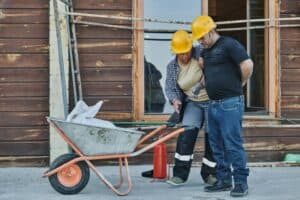
Table of Contents
- Introduction
- Falls from Heights
- Struck-By Incidents
- Electrocution Hazards
- Caught-In/Between Accidents
- Slips, Trips, and Falls
- Heavy Machinery Accidents
Introduction
Construction sites are among the most dangerous workplaces in the United States, presenting workers with various hazards daily. The ever-changing nature of a construction worksite, with its heavy machinery, exposed wires, elevated surfaces, and frequent movement of materials and personnel, ensures that hazards are seldom far from view. Workers face not only the risk of immediate and severe injuries but also long-term health complications due to repetitive exposure to physical and environmental dangers. Recognizing the most common construction accident risks—and having a clear strategy for managing each one—is vital for ensuring workplace safety. Awareness alone is not enough; a culture that emphasizes prevention and continuous training is essential. If you or someone you know has experienced an injury on a worksite, resources such as Injury Law Partners can offer invaluable legal guidance, helping injured workers understand their rights and pursue compensation when accidents occur.
Proper training, reliable safety equipment, and regularly updated procedures are indispensable for workers and employers aiming to minimize the risk of accidents. Safety must be a priority, not simply a checklist before beginning work. Every worker has a role, from reporting unsafe conditions to following correct operating procedures and appropriately using personal protective equipment (PPE). Likewise, employers are responsible for providing ongoing education and ensuring all equipment and protective gear are up to standard. In the sections below, we detail the most frequent construction accident risks, outline steps to prevent them, and explain why constant vigilance cannot be compromised if we hope to achieve a safe workplace.
Falls from Heights
Falls are the leading cause of death and severe injury in the construction industry, contributing to almost 40% of construction-related fatalities. Working at significant heights, often on roofs, ladders, or scaffolding, exposes workers to a constant danger of falling. Common factors include unprotected edges, temporary but unstable surfaces, scaffolding that hasn’t been properly constructed or inspected, or failure to use essential fall protection equipment. Even a seemingly minor fall of just a few feet can result in broken bones, traumatic brain injuries, or even death. As work progresses, a site’s configuration often changes rapidly, making consistent safety precautions and communication vital. Ensuring that all safety measures are proactively enforced can mean the difference between life and death for everyone on site.
How to Prevent Falls from Heights
- Always utilize guardrails, safety nets, and personal fall arrest systems for any task performed above ground level. This is non-negotiable in areas where workers are at risk of falling.
- Conduct regular inspections of ladders, scaffolding, and harnesses to ensure their stability and structural integrity prior to each use. Report and replace any defective equipment immediately.
- Provide comprehensive fall prevention and rescue training to all workers, including how to use protective systems correctly and respond in the event of a fall. Make sure everyone understands the risks associated with their specific job site and knows what to do in case of an emergency.
Struck-By Incidents
Struck-by incidents rank among the top causes of construction site injuries and fatalities, sometimes with catastrophic results. These incidents happen when workers are hit by moving vehicles, falling tools, flying debris, or heavy equipment. Busy and congested sites, often filled with multiple crews and trades, increase the risks of visibility issues and communication breakdowns. These situations can be worsened by poor lighting, inadequate signage, or workers not wearing the right PPE, like hard hats or high-visibility vests. The fast-paced nature of construction often means that dangerous situations can arise very quickly, making constant attentiveness vital. Reducing ‘struck-by’ risks is possible through a combination of clear protocols, rigorous enforcement, and a team-wide commitment to maintaining situational awareness.
How to Prevent Struck-By Incidents
- Implement and practice clear, site-wide communication protocols to ensure everyone is aware of moving vehicles or equipment. When vehicles are operating on site, utilize designated spotters or traffic coordinators.
- Create and enforce the use of high-visibility clothing and the required personal protective equipment for all workers and visitors, making it easier for everyone to see and be seen.
- Maintain exclusion zones around areas where heavy or moving equipment is being operated, restricting access at all times to only authorized personnel to minimize unnecessary exposure to risk.
Electrocution Hazards
Electrocution is the third leading cause of fatalities among construction workers. The danger is constantly present, whether from contact with overhead or underground power lines, exposure to faulty wiring, or incorrect use of electrical tools and machinery. Because electricity is both invisible and unforgiving, a single misstep can have fatal consequences. The risks are further heightened by rapid changes in the work environment and the constant introduction of new or temporary electrical sources. Ensuring everyone onsite understands the significance of lockout/tagout (LOTO) procedures, the critical importance of never bypassing safety devices, and properly handling electrical materials is non-negotiable. Injuries resulting from electrical accidents can range from burns to severe internal damage, making prevention the highest priority.
How to Prevent Electrocution Hazards
- Always de-energize circuits and follow lockout/tagout procedures before commencing electrical work, maintenance, or repairs—this is the most effective way to ensure no one is accidentally exposed to live wires.
- Workers should use insulated tools and rubber-soled boots designed to provide maximum protection from electrical currents, and all tools should be inspected regularly to confirm their condition.
- Maintain a safe working distance from all power lines, regardless of voltage, and ensure that all equipment is properly grounded to prevent electrical arcs, shorts, or accidental contact. For more detailed industry standards and recommendations, see the official OSHA Construction Industry resource.
Caught-In/Between Accidents
Caught-in or caught-between accidents occur when workers get trapped, crushed, or compressed between two or more objects or machinery. This risk is particularly serious during tasks involving heavy machinery, excavation, or trench work, where cave-ins and machinery rollovers can quickly turn fatal. These incidents can happen in a split second, with little or no warning, as equipment shifts, trenches collapse, or machine guards fail. Strict adherence to safe operating procedures, the use of protective systems for any excavation, and never entering trenches or confined spaces without proper assessment are critical steps in minimizing incidents of this nature. Making sure machinery is always guarded and that only qualified personnel are allowed to operate hazardous equipment are additional safeguards that protect lives and prevent life-altering injuries.
How to Prevent Caught-In/Between Accidents
- Employ robust protective systems—including trench boxes, shoring, and proper sloping—for all excavation work, ensuring that cave-ins and collapses are prevented and escape routes are always accessible.
- Ensure that all machinery is equipped with appropriate guards, is in correct working order, and is operated only by individuals who have received thorough training and certification.
- Train workers to recognize caught-in/between hazards and enforce compliance with safe work practices at all times, especially when working around moving parts or heavy vehicles.
Slips, Trips, and Falls
Slips, trips, and falls that occur on the same level are some of the most frequent—but deceptively dangerous—incidents on construction sites. The main culprits are often wet or uneven surfaces, debris scattered across working areas, walkway obstacles, and poor or inconsistent lighting. Even when injuries seem minor initially, they can often result in lingering pain, lost productivity, and higher medical costs. Beyond the physical effects, such accidents can disrupt workflow, trigger work stoppages, and undermine overall morale. Maintaining a neat and orderly work environment is key to significantly reducing these preventable injuries and ensuring every worker can navigate the site safely and efficiently.
How to Prevent Slips, Trips, and Falls
- Keep all working areas clean, orderly, and free from loose materials or misplaced tools. Enforce routine housekeeping policies and waste management across every crew and shift.
- All employees must wear high-quality, slip-resistant footwear suited for the specific terrain or daily conditions.
- Clearly mark all hazardous areas, including slippery or uneven surfaces, and ensure adequate, consistent lighting throughout the job site so that workers are always aware of their surroundings.
Heavy Machinery Accidents
Heavy machinery—such as cranes, bulldozers, forklifts, and excavators—is essential for building and lifting tasks, but the stakes are high. When these machines are operated by undertrained personnel, neglected during maintenance, or used improperly, the resulting accidents can be devastating. Common causes include operator error, mechanical failure, unclear hand signals, and poor coordination between those on foot and those operating equipment. The sheer mass and power of these machines mean that even minor mishaps can lead to severe injuries or fatalities. Preventing these incidents starts with operator competency, strict adherence to maintenance schedules, and clear, reinforced communication protocols every time heavy machinery is used.
How to Prevent Heavy Machinery Accidents
- All equipment operators must complete proper, accredited training and hold any necessary certifications before using heavy machinery.
- Implement a strict regime of regular inspections and thorough maintenance checks for all heavy equipment, addressing mechanical issues promptly to avoid breakdowns or malfunctions on site.
- Establish—and enforce—comprehensive communication protocols, using hand signals, radios, or other devices appropriate for noisy or chaotic environments, so everyone is clear about movements and intentions around equipment.
Construction accidents are preventable when a strong safety culture is in place and everyone on site remains committed to vigilance and continuous improvement. By understanding the key risks, proactively implementing safety procedures, and prioritizing both worker training and site organization, both employers and workers can create a safer working environment for all. Stay up to date, prioritize safety, and turn to resources if you need legal help navigating an accident or injury.



